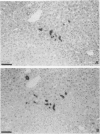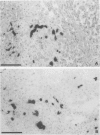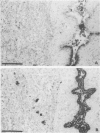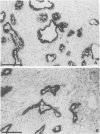Abstract
The expression of tumour markers CA 19-9 and CA 50, defined by the monoclonal antibodies 1116 NS 19-9 (19-9 antibody) and C 50, was studied by the immunoperoxidase technique in formalin-fixed, paraffin-embedded tissue sections from 11 hepatocellular carcinomas and 10 cholangiocarcinomas of the liver, and from specimens of normal liver and liver cirrhosis. The 19-9 and C 50 antibodies react with sialosylfucosyllactotetraose, corresponding to sialylated blood group antigen Lewis, and the C 50 antibody also with another sugar moiety, sialosyllactotetraose. Neither marker was cancer specific. The CA 19-9 and CA 50 antigens are normal constituents of bile ducts. Nine out of 10 cholangiocarcinomas stained for CA 50, and eight out of 10 for CA 19-9. There was no apparent difference between the staining pattern of CA 19-9 and CA 50. Hepatocellular carcinomas were consistently negative for both markers. Thus, hepatocellular carcinomas and cholangiocarcinomas showed a clear difference in the reactivity for tumour marker antigens CA 19-9 and CA 50. This difference might be of clinical importance in the differential diagnosis between hepatocellular carcinoma and cholangiocarcinoma.
Full text
PDF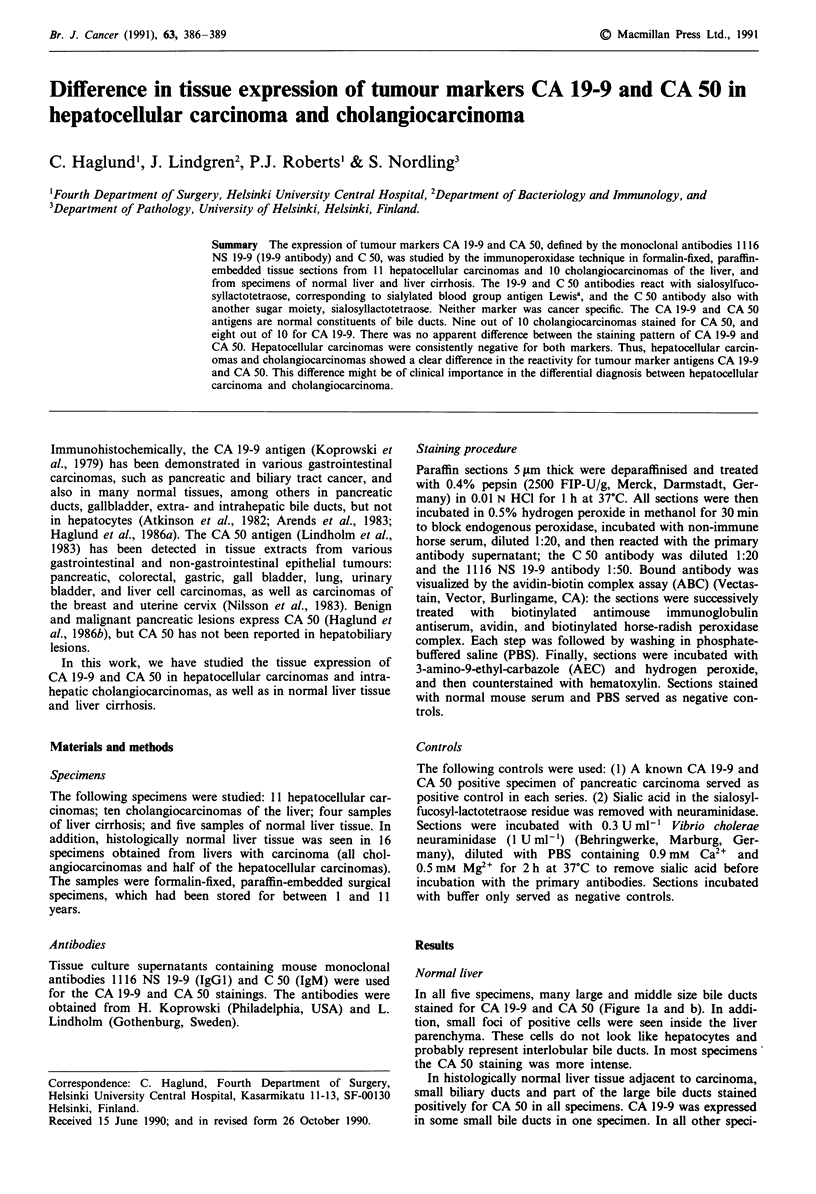
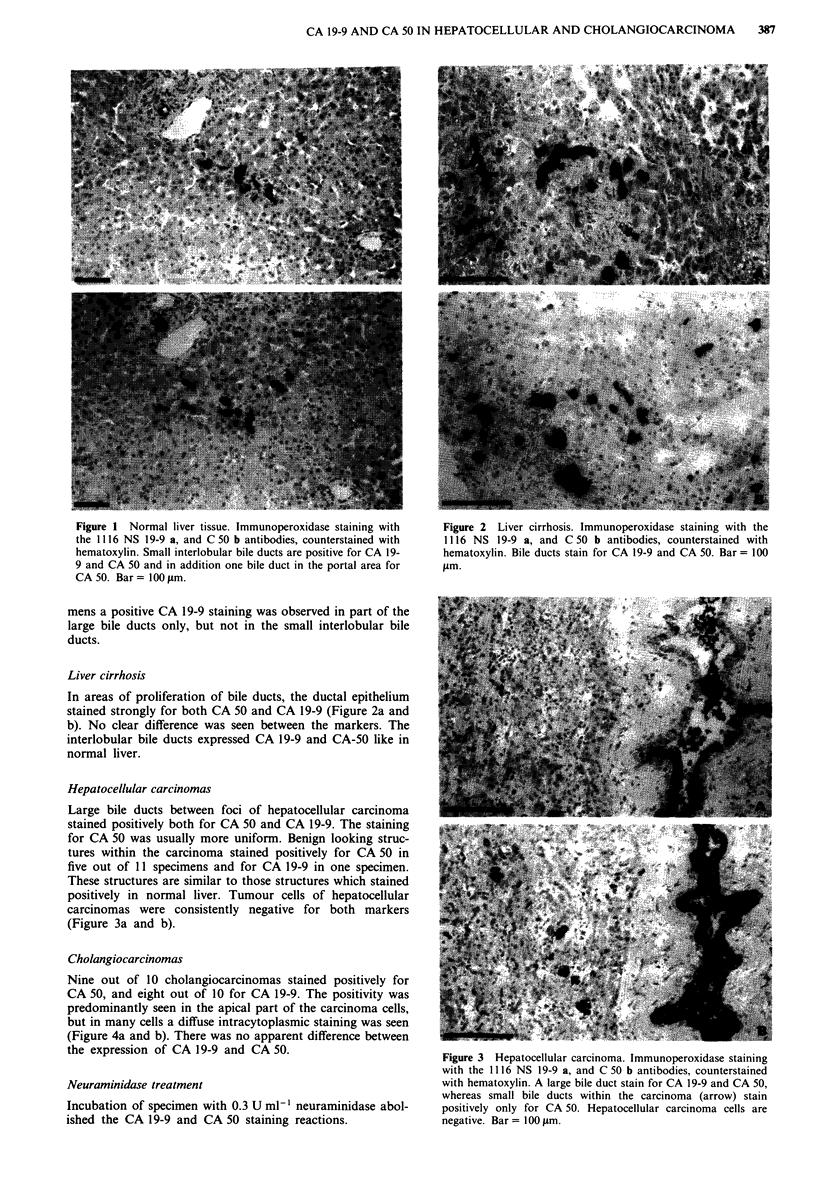
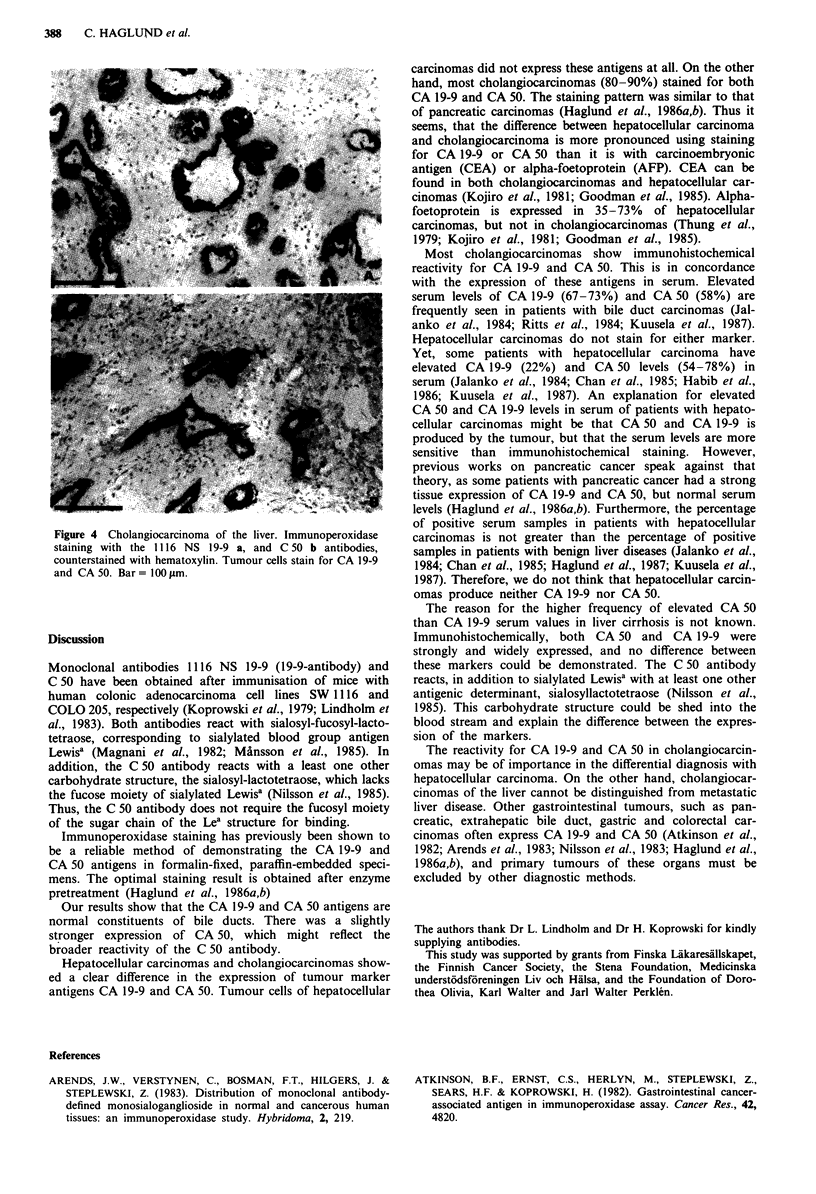
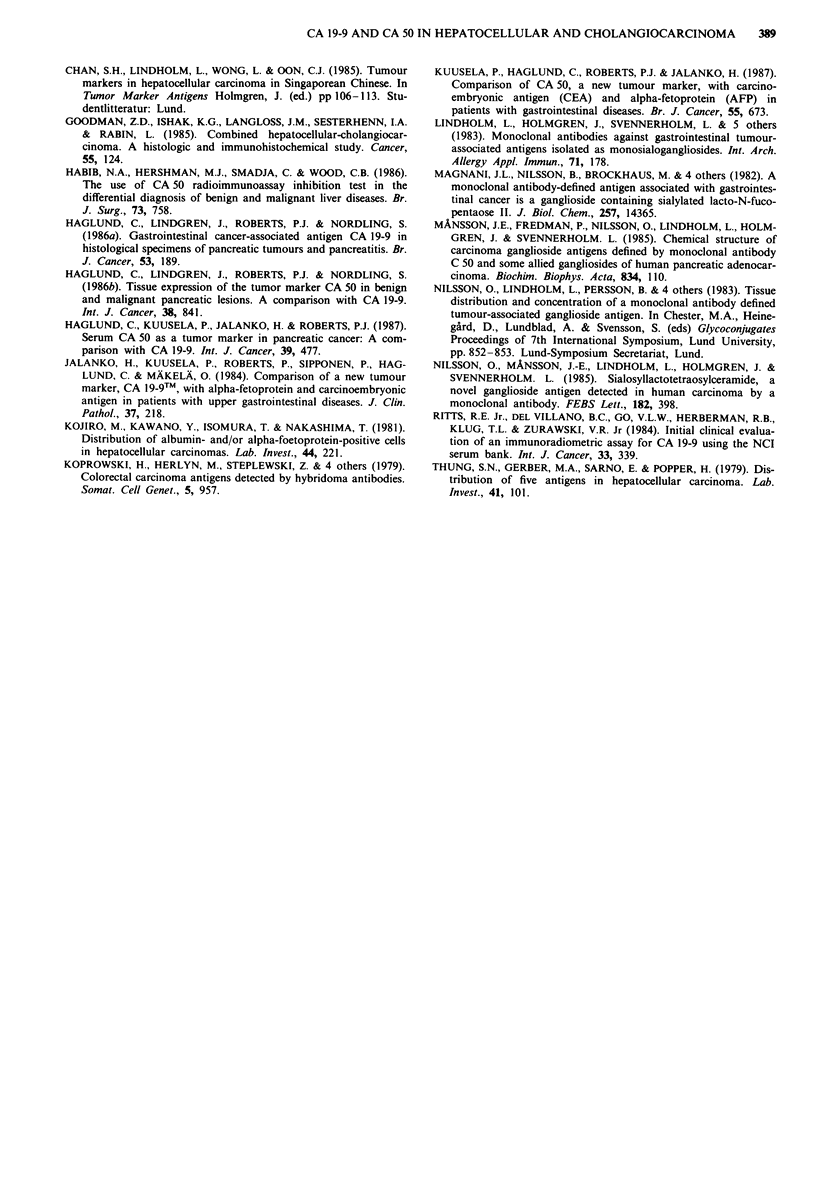
Images in this article
Selected References
These references are in PubMed. This may not be the complete list of references from this article.
- Arends J. W., Verstynen C., Bosman F. T., Hilgers J., Steplewski Z. Distribution of monoclonal antibody-defined monosialoganglioside in normal and cancerous human tissues: an immunoperoxidase study. Hybridoma. 1983;2(2):219–229. doi: 10.1089/hyb.1983.2.219. [DOI] [PubMed] [Google Scholar]
- Atkinson B. F., Ernst C. S., Herlyn M., Steplewski Z., Sears H. F., Koprowski H. Gastrointestinal cancer-associated antigen in immunoperoxidase assay. Cancer Res. 1982 Nov;42(11):4820–4823. [PubMed] [Google Scholar]
- Goodman Z. D., Ishak K. G., Langloss J. M., Sesterhenn I. A., Rabin L. Combined hepatocellular-cholangiocarcinoma. A histologic and immunohistochemical study. Cancer. 1985 Jan 1;55(1):124–135. doi: 10.1002/1097-0142(19850101)55:1<124::aid-cncr2820550120>3.0.co;2-z. [DOI] [PubMed] [Google Scholar]
- Habib N. A., Hershman M. J., Smadja C., Wood C. B. The use of CA-50 radioimmunoassay inhibition test in the differential diagnosis of benign and malignant liver diseases. Br J Surg. 1986 Sep;73(9):758–759. doi: 10.1002/bjs.1800730927. [DOI] [PubMed] [Google Scholar]
- Haglund C., Kuusela P., Jalanko H., Roberts P. J. Serum CA 50 as a tumor marker in pancreatic cancer: a comparison with CA 19-9. Int J Cancer. 1987 Apr 15;39(4):477–481. doi: 10.1002/ijc.2910390412. [DOI] [PubMed] [Google Scholar]
- Haglund C., Lindgren J., Roberts P. J., Nordling S. Gastrointestinal cancer-associated antigen CA 19-9 in histological specimens of pancreatic tumours and pancreatitis. Br J Cancer. 1986 Feb;53(2):189–195. doi: 10.1038/bjc.1986.34. [DOI] [PMC free article] [PubMed] [Google Scholar]
- Haglund C., Lindgren J., Roberts P. J., Nordling S. Tissue expression of the tumor marker CA 50 in benign and malignant pancreatic lesions. A comparison with CA 19-9. Int J Cancer. 1986 Dec 15;38(6):841–846. doi: 10.1002/ijc.2910380610. [DOI] [PubMed] [Google Scholar]
- Jalanko H., Kuusela P., Roberts P., Sipponen P., Haglund C. A., Mäkelä O. Comparison of a new tumour marker, CA 19-9, with alpha-fetoprotein and carcinoembryonic antigen in patients with upper gastrointestinal diseases. J Clin Pathol. 1984 Feb;37(2):218–222. doi: 10.1136/jcp.37.2.218. [DOI] [PMC free article] [PubMed] [Google Scholar]
- Kojiro M., Kawano Y., Isomura T., Nakashima T. Distribution of albumin- and/or alpha-fetoprotein-positive cells in hepatocellular carcinoma. Lab Invest. 1981 Mar;44(3):221–226. [PubMed] [Google Scholar]
- Koprowski H., Steplewski Z., Mitchell K., Herlyn M., Herlyn D., Fuhrer P. Colorectal carcinoma antigens detected by hybridoma antibodies. Somatic Cell Genet. 1979 Nov;5(6):957–971. doi: 10.1007/BF01542654. [DOI] [PubMed] [Google Scholar]
- Kuusela P., Haglund C., Roberts P. J., Jalanko H. Comparison of CA-50, a new tumour marker, with carcinoembryonic antigen (CEA) and alpha-fetoprotein (AFP) in patients with gastrointestinal diseases. Br J Cancer. 1987 Jun;55(6):673–676. doi: 10.1038/bjc.1987.137. [DOI] [PMC free article] [PubMed] [Google Scholar]
- Lindholm L., Holmgren J., Svennerholm L., Fredman P., Nilsson O., Persson B., Myrvold H., Lagergård T. Monoclonal antibodies against gastrointestinal tumour-associated antigens isolated as monosialogangliosides. Int Arch Allergy Appl Immunol. 1983;71(2):178–181. doi: 10.1159/000233384. [DOI] [PubMed] [Google Scholar]
- Magnani J. L., Nilsson B., Brockhaus M., Zopf D., Steplewski Z., Koprowski H., Ginsburg V. A monoclonal antibody-defined antigen associated with gastrointestinal cancer is a ganglioside containing sialylated lacto-N-fucopentaose II. J Biol Chem. 1982 Dec 10;257(23):14365–14369. [PubMed] [Google Scholar]
- Månsson J. E., Fredman P., Nilsson O., Lindholm L., Holmgren J., Svennerholm L. Chemical structure of carcinoma ganglioside antigens defined by monoclonal antibody C-50 and some allied gangliosides of human pancreatic adenocarcinoma. Biochim Biophys Acta. 1985 Mar 27;834(1):110–117. doi: 10.1016/0005-2760(85)90182-1. [DOI] [PubMed] [Google Scholar]
- Nilsson O., Månsson J. E., Lindholm L., Holmgren J., Svennerholm L. Sialosyllactotetraosylceramide, a novel ganglioside antigen detected in human carcinomas by a monoclonal antibody. FEBS Lett. 1985 Mar 25;182(2):398–402. doi: 10.1016/0014-5793(85)80341-0. [DOI] [PubMed] [Google Scholar]
- Ritts R. E., Jr, Del Villano B. C., Go V. L., Herberman R. B., Klug T. L., Zurawski V. R., Jr Initial clinical evaluation of an immunoradiometric assay for CA 19-9 using the NCI serum bank. Int J Cancer. 1984 Mar 15;33(3):339–345. doi: 10.1002/ijc.2910330310. [DOI] [PubMed] [Google Scholar]
- Thung S. N., Gerber M. A., Sarno E., Popper H. Distribution of five antigens in hepatocellular carcinoma. Lab Invest. 1979 Aug;41(2):101–105. [PubMed] [Google Scholar]



